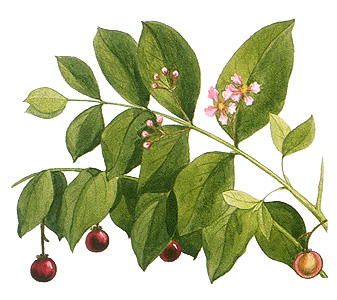Acerola, << `as` uh ROH luh, >> is the fruit of a bushy tree that grows 10 to 15 feet (3.0 to 4.6 meters) tall. It is native to the West Indies and parts of Mexico, Central America, and northern South America. The tree has deep roots and grows well even in poor soil, if there is enough rain. The acerola is also called the Puerto Rican, West Indian, or Barbados cherry. The fruits are about the size of cherries. When ripe, acerolas have a deep red color and soft flesh. Most have a tart flavor.

The fruits are rich in vitamin C (ascorbic acid). The vitamin C content varies in different varieties and under different environmental conditions. Green fruits contain more vitamin C than ripe fruits. The edible part of the acerola has about 1 to 4 percent ascorbic acid. In other kinds of fruits, even 0.06 percent ascorbic acid is high. The acerola ranks as the richest known natural source of vitamin C. Jelly and juices made from acerolas retain the fruit’s high vitamin C content.
The acerola was eaten by Indians long before the Europeans came to the Western Hemisphere. During the late 1940’s, commercial canners began to use the acerola in fruit juice mixes. Today, the fruit is an important crop in Puerto Rico.
